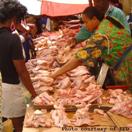Mismanaged African poultry imports cause health hazzard

Africa has become the main destination for left over poultry parts from Brazil, the European Union and the United States.
Though poultry exports from Europe, for example, are produced to the same standards as those consumed and marketed within Europe, once the products reach the ports in importing countries, there’s no longer a way to manage that the frozen products will reach consumers in the same condition.
In several West African countries, like Ghana, electricity isn’t constantly provided. This creates a major health risk as imported poultry partially or completely defrosts, allowing bacteria such as salmonella to flourish.
Once imported poultry leaves the port, its next destination is usually middlemen who sell the meat to shopkeepers or stallholders in local markets; these traders also have difficulties keeping the poultry frozen. Supermarkets like those seen in wealthier countries are rare in many parts of Africa, even in capital cities. Chicken sold in local markets is often sold in the open sun, which is not only unhygienic, but the chicken often defrosts in the sun before it is sold. The unsold chicken is put back in freezers overnight, set out in the sun again the next day to be sold, then reverts to the freezers. This process can go on for months.
The EU has pledged to help developing countries in Africa, the Caribbean and the Pacific (referred to as the ACP) develop their domestic infrastructure so they can better participate in world trade, under the auspices of Economic Partnership Agreements.
These accords must be in place by the end of 2007 to bring ACP-EU trade into compliance with the World Trade Organisation‘s regulations, and would see ACP markets being opened to European goods.
Related articles:













